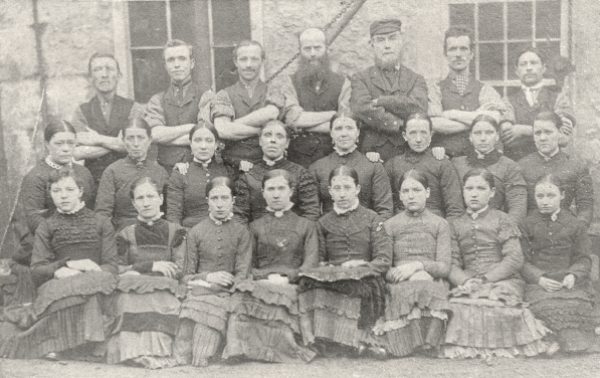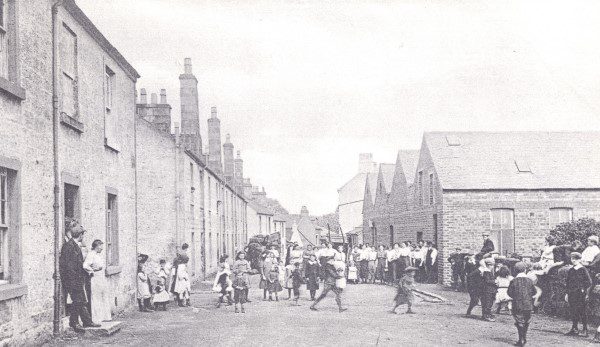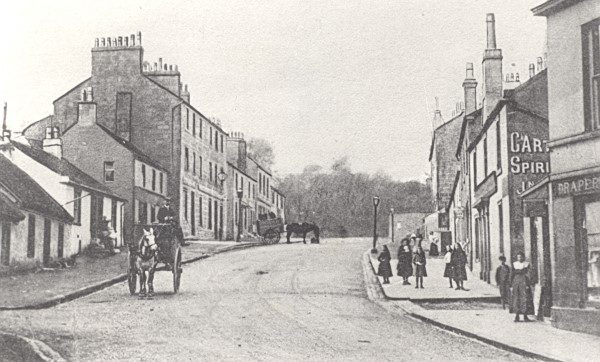

History of Busby
Read on to discover the origins of Busby
Today mainly residential in nature, Busby has a hidden past as a busy industrial village, which grew as a result of the textile industry. From the late 18th century it flourished, with two cotton mills and a printworks providing employment, and quickly developed as a centre for industry and innovation. The population grew quickly and with that came all the trappings of daily life, including shops, schools, churches and recreational facilities. Read on to discover more.
Busby has undoubtedly been an attractive place to live from the earliest times with its access to the plentiful water supply from the White Cart. A trace of early habitation remains in Busby Glen where some form of iron age enclosure or cairn was established.
There was a meal mill at the waterfall, which can be traced back to 1300, and over the centuries the river was harnessed to power various types of small mill, for example lint, waulk and grain mills. The name Busby was originally Bushby and it was referred to as this on John Ainslie’s map of 1792. Before this however, the area was actually known as Newmill and can be seen on Blaeu’s atlas of 1654.
Busby’s development as a village really took off during the industrial revolution, which had its peak during the 19th century. It became a thriving industrial town because the good quality water supply from the White Cart was the perfect source of power for the cotton industry. It was also reasonably close to Glasgow to allow for the easy import and export of goods. At this time it was much bigger than neighbouring Clarkston, a situation which is now reversed.
In 1778 the first cotton mill in Renfrewshire and fourth in Scotland, was established at Newmill by a Glasgow Merchant, William Ferguson (Busby Upper Mill). In 1788, Manchester merchants, James Doxon and Robert Twyford, bought the mill with plans to expand, but because the mill was situated in a hollow, it made it difficult to build on to. Instead, Doxon decided to build another mill further downstream. This was also challenging as the site of the second mill was shielded by a spur of high ground ending with a sheer drop. Doxon’s first idea to drive the second mill was to build a dam or weir at the foot of the spur. However, in 1796 there was there was a different solution – a tunnel through the rock spur linked to the tail race of the upper mill by a culvert. The structure survives to this day and in 2014, the remains of Busby Upper Mill were designated a scheduled monument by Historic Environment Scotland.
The mills went through various hands but in 1843, they were bought by James Crum who was from the same family who owned the successful printworks in Thornliebank. The Busby mills were managed by James and then his widow Agnes for 30 years.
In 1796, Busby printworks were opened by David Kessock on the site of Busby meal mill where the Whitecart Industrial Estate now stands. In 1802 it had a setback when it was sequestered by the government. Kessock was caught forging excise stamps. (stamps put on items to show the tax had been paid).
However, it was reopened and continued to operate into the 20th century. It produced a variety of goods made from printed calico. By 1883 it took up 7 acres, 3000 pieces of cotton were produced daily, it employed 600 workers and had a bleachfield attached to it.

Other industries also grew up in Busby to service the growing community. Busby Gasworks was established in the 1830s near Lower Mill, initially servicing the mills but then also going on to provide the gas supply for the town. Busby Water Company was formed 1875 when filter works and reservoirs were constructed ¾ mile east of Carmunock. In 1882 the system was extended to Eastwood Toll via Sheddons and Clarkston Toll and by 1888-1905 it was extended again to lower Giffnock, Netherlee and Bogton. Unfortunately, the water was filthy and eventually the supply was taken over, first by Glasgow Corporation and then by Renfrew County Council. Rags had to placed under the taps to catch the solid matter which came through before it was able to be used.
The boom of the textile industry meant that Busby village grew as people came to work and live there. The workers had to be housed and the mill owners built houses for them and gathered the rent. Early workers’ housing consisted of rows of single storey thatched cottages such as Smithy Row which was located 100 yards from the Lower Mill. These were superseded by two-storey terraces and then later, larger sandstone tenements became more popular as more families could be housed in a smaller piece of land. These blocks of housing were commonly known as ‘lands’ The printworks’ owners built Church Land, Struther’s Land and Printer’s Land.
This picture shows Burnside Terrace in 1910. This street is now called Riverside Terrace and has newer flats on it. It was originally known as Spinners Land.

Everyday life
Employees at the mills and printworks worked long hours under harsh conditions. A typical working day in the mills lasted at least 12 hours Monday to Friday with a shorter day on a Saturday. There were two days holiday per year. The statistical accounts of 1792 shows that at this time 360 people were employed in the mills at Busby.
Males under 15 – 100
Females under 15 – 110
Males over 15 – 60
Females over 15 – 90
It is noticeable that the majority of people working in the mill at this point were under 15. The children had the same working conditions as the adults and all worked in a hot damp atmosphere, which was conducive to bronchitis, pneumonia and tuberculosis. Millions of fibre particles in the air could lead to silicosis of the lungs.
In 1805 the government passed an act which said that the working hours of children would be limited to 12 hours a day and that the last 2 hours had to be spent in reading, writing and arithmetic.
Due to its increase in size, Busby became a social centre for surrounding areas. It developed infrastructure which allowed it to cater for the recreational, education and religious aspects of village life. Between 1841 and 1881, Busby had a Literary Society, a Mechanics Institute, a library, a small school and one of Scotland’s earliest penny savings bank. Sports also became popular as a past time and Busby Cartvale Football Club was founded in 1874.
Shops and businesses opened to cater for local needs and everything that a resident would need for day to day living could be purchased in the village.

Although conditions in the mills and printworks left much to be desired, some of the owners carried out acts of generosity which contributed to development of the village.
James Crum for example, paid for an addition of a back gallery to what is now Busby West Parish Church in 1814. David McKean, who owned the printworks between 1829 and 1834 began a small circulating library to stimulate the reading habit in young men and boys. He also visited cholera sufferers during the outbreak in the village in 1832. David was also concerned with the spiritual welfare of his workers and paid for a missionary, a Mr Samuel Kent. In 1829, Mr Kelly, joint proprietor of the mills actually gave his house to be used as a hospital for cholera sufferers.
When James Crum died, his widow Agnes continued to run the mills. He left a large sum of money, £63,939, but when Agnes died all that remained was a paltry £784. As well as some poor investments, and helping her nephews with their business venture, Agnes had used up her money keeping the mills open so that the employees didn’t suffer and also financed the costs of the Busby school in Church Road until 1872.
Before 1835 there were no churches in Busby. People had to travel to Mearns, East Kilbride, Carmunock and Cathcart, which was quite a distance especially as they would mostly walk. This became a huge problem in 1832 during the cholera epidemic. No one was allowed to attend parish churches in case they spread the disease and watchmen guarded the routes to enforce this. For 3 years the people of Busby relied on the ministry of 2 students – Mr. Robert Niven and Mr. David Jamieson. (who became the first minister of Busby’s first church)
In 1835 a petition was handed into the Secession Presbytery of Glasgow and Busby was granted a church. It was opened in 1836 and was known as the United Secession Church. (Now Busby West). It cost £930 to build.
In 1865, the Free Church was constituted in Busby and what was later Busby East Church was built.
Because of the cotton mills a lot of people from Ireland came over to work and live in Busby. This made the Roman Catholic Population grow and in the 1880s St. Joseph’s was built at Sheddens. Before that Roman Catholics had to travel all the way to Eaglesham to worship.
As a result of the 1872 Education (Scotland) Act which made primary education mandatory, Busby School was opened in 1876 to serve Mearns, Carmunnock and Cathcart. The original building was destroyed by fire in 1900, but a new school was opened by Mr. John Robb JP, the Chairman of the School Committee on the 12th Feb 1904. This B-listed building still serves the Busby Community today.
Industrial decline and the twentieth century
In 1901, the printworks were bought over by the Calico Printers Association who owned 85% of the printing industry in Britain. They had a policy of closing smaller works and the Busby works was closed in 1901. 500 men and women suddenly found themselves unemployed and the local population began to decrease.
However, even though the industries declined and the fortunes of Busby waned for a time, its potential as a residential suburb soon began to be realised.
In 1866 the railway had come to Busby and it was now a quick easy journey to get there from Glasgow. The line had been heavily used for freight and mineral traffic but it also allowed people to come to Busby to live and travel back to Glasgow to work. At lot of wealthy merchants and business men began to build grand houses on the Lanarkshire side of the Cart and brought their families to live there. They were attracted to Busby as it was near the countryside and was thought to have good clean healthy air.
A bit of a divide grew up between the workers living on the Renfrewshire side in poorer conditions and the rich people living in luxury in the big Lanarkshire houses.
In the 1920s and 30s, there were a lot of council house building programmes undertaken. In 1929, the Bon Accord cottages were built and the 1930s saw building in Hawthorn Road, Birch Ave, Birch Crescent, Cartsbridge Road, Elm Street and some in Riverside Terrace.
World War II called a halt to building and it wasn’t in the 1950s that there was another building boom. Again council houses were built in Cartside Road, Mossgiel Crescent, Ellisland Road, Oliphant Crescent and Southview Avenue.
By the 1960s the village was becoming a bit run down, so in 1968 it became a comprehensive development area and it was decided that there should be a planned development of elderly people’s housing incorporating shop units.
The local development plan of 1973 identified that Busby needed considerable action to revitalise the village. The council was keen to encourage private housing an example being ‘The Paddock’ (Sir Alfred McAlpine)
Busby continues today as a residential area which still retains its village identity. The main street has a library, a community hall and a selection of vibrant shops and businesses as well as the long established Cartvale Bar and the Busby Hotel.
